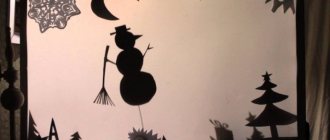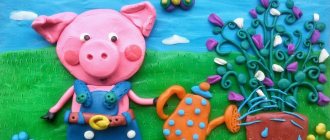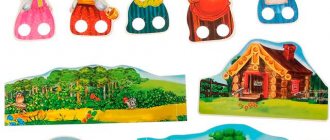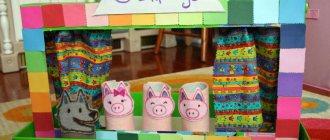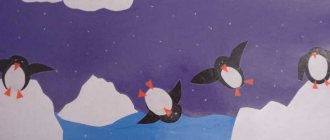Dedicated to needlewomen. It turns out that it’s not at all difficult to make a puppet theater with your own hands from paper - printable templates are at hand. You need a little patience, which lovers of creativity have more than enough of. And a minimum of items. The ready-made patterns presented in the article will make the task much easier. Here you will find plenty of details for your favorite activity. All that remains is to save the images and then print them on a printer.
Why are such theaters made? All children love fairy tales. Why, even adults are not averse to listening to exciting stories with a happy ending. The works are very interesting to listen to, however, visually they are perceived in a completely different way. They are better remembered and leave more vivid impressions.
There are many variations for making puppet theaters. The easiest one is to make it out of paper. Available materials, a minimum of time, you can involve children in creating - here is a small set of advantages that are enough to resort to such needlework.
Don't be limited by the printable templates below. Diversify your puppet theater with decorations from improvised materials.
Are your children too young to carve on their own? Invite them to collect the scraps in a separate box. Also an important contribution. And then gather a family evening watching a paper play that is interesting not only to watch, but also to present to the audience.
Is it difficult to do
It probably sounds a little scary: make a puppet theater! But in reality there is nothing complicated here. Most of us attended kindergartens in our early childhood.
It was mandatory for any group to have a theater area, and, of course, the dolls were made by the teachers themselves. Now this process has become much easier. It is enough to look at various photos of a do-it-yourself puppet theater on the Internet, and immediately, firstly, it will become clear that making the scenery is not at all difficult, and, secondly, you will probably want to get to work as soon as possible. Making puppet theater with a child is very interesting.
Complicated version
You can create a shadow theater for children using templates with your own hands in half an hour, but if you have more time, it’s worth thinking through additional details. For example, add decorations. They are created from cardboard and attached tightly to the screen using tape or paper clips. Then the decorations will not fall unexpectedly.
It’s easy to “revive” the figures - make them more mobile using soft wire. It is used to wrap arms, legs, wings and other parts.
It’s easy to “play up” an evening with a performance: decorate the curtain and draw bright tickets. And if several performances are planned, print out programs for spectators. And, of course, you need an intermission, during which you can treat the audience to delicious home-cooked food.
Plot-script
For the plot, it is very convenient to choose the famous Russian fairy tales “Teremok”, “Kolobok”, “Masha and the Bear”. The main characters are animals. animal puppets for a puppet theater with your own hands : on the Internet you can easily find a large number of patterns, both simple and complex. Or you can use soft toys such as a fox, a hare, a bear as animal dolls.
Russian fairy tales are very fertile material for production. The characters are simple and understandable, and the repetitions in the plot that fill fairy tales contribute to the development of memory in children and promote the development of speech. In addition, these fairy tales are well known to parents, so creating a performance based on them will not be difficult.
Project "Theater for Kids"
Age group: second youngest group (3-4 years).
Project goal: To introduce children to theatrical culture.
Relevance:
Today, when the problem of preschool education and upbringing is being widely and fundamentally solved and the tasks facing teachers of preschool educational institutions are becoming more complex, the task of introducing children to theatrical activities from a very early age remains very important.
Creative activity and the development of human creative abilities are an integral part of the socio-economic and spiritual directions of the modern social structure. The word “creativity” in the social sense means to search for, to depict something that has not been encountered in past experience, individual and social. Creative activity is an activity that gives birth to something new; the free art of creating a new product that reflects the personal “I”. Creativity is not only the creation of something new in material and spiritual culture, but also a person’s improvement of himself, primarily in the spiritual sphere.
Children's creativity is one of the pressing problems of preschool pedagogy and child psychology. It was studied by L. S. Vygotsky, A. N. Leontiev, L. I. Venger, N. A. Vetlugina, B. M. Teplov, O. M. Dyachenko, A. I. Volkov and many others.
Theatrical activity is the most common type of children's creativity. It is close and understandable to the child, lies deeply in his nature and is reflected spontaneously, because it is connected with play. The child wants to translate any of his inventions, impressions from the life around him into living images and actions. Entering the character, he plays any role, trying to imitate what he saw and what interested him, and receiving great emotional pleasure.
Theater activities help develop the child’s interests and abilities; contribute to overall development; manifestation of curiosity, desire to learn new things, assimilation of new information and new ways of action, development of associative thinking; perseverance, dedication to the manifestation of general intelligence, emotions when playing roles. In addition, theatrical activities require the child to be decisive, systematic in work, and hardworking, which contributes to the formation of strong-willed character traits. The child develops the ability to combine images, intuition, ingenuity and ingenuity, and the ability to improvise. Theatrical activities and frequent performances on stage in front of audiences contribute to the realization of the child’s creative powers and spiritual needs, emancipation and increased self-esteem. Alternating the functions of performer and spectator, which the child constantly takes on, helps him demonstrate to his comrades his position, skills, knowledge, and imagination.
Exercises for the development of speech, breathing and voice improve the child’s speech apparatus. Completing game tasks in the images of animals and characters from fairy tales helps to better master your body and understand the plastic possibilities of movements. Theatrical games and performances allow children to immerse themselves in the world of fantasy with great interest and ease, and teach them to notice and evaluate their own and others’ mistakes. Children become more relaxed and sociable; they learn to clearly formulate their thoughts and express them publicly, to feel and understand the world around them more subtly.
The love for theatrical creativity, the desire to pass this love on to children, the desire to make a child’s life happier and his inner world richer through theatrical skill, became the reference point for the creation of this project.
Project objectives:
- Create conditions for the development of children's creative activity in theatrical activities.
- Teach children various means of improvisation.
- To form children's ideas about various types of theater and theatrical genres.
- Provide conditions for the relationship between theatrical and other activities.
- Involve children in dramatizing small works.
- Learn to convey the habits of animals in movements, create playful images, instill communicative qualities, and the ability to move in the character of music.
- Develop children's dialogical speech.
- Learn to read individual lines of dramatization expressively.
- Form the need to share your impressions with the teacher and parents.
10. Create conditions for joint activities of children and adults.
Project participants:
- Pupils of the group.
- Group teacher.
- Parents of group children.
- Musical director.
Stages and timing of the project: March (3-4 weeks) from March 14 to March 25, 2016.
Expected results:
Child development in all areas of educational fields.
Significant expansion of children's ideas about theatrical culture.
Creating a subject environment that promotes the development of theatrical culture in children.
Forms of working with children:
- organization of educational, developmental and creative activities;
- organizing joint events with parents;
- organization of theater evenings (showing fairy tales and performances);
Theater classes in the second junior group.
During theater classes, children learn the simplest techniques for controlling tabletop theater puppets. You can suggest coming up with small stories that happen with the toy, so that the child can compose dialogues himself and find expressive intonations. At the same time, you can provide assistance with leading questions, without providing a ready-made role model. No matter how primitive the stories written by children are, encouragement is necessary. The child must be encouraged to want to play with the doll. Acting out written fairy tales spiritually liberates the child and you need to pay attention to this. In theater classes, it is necessary to create an atmosphere of goodwill, mutual trust, and respect for each other. A child can only create when he feels the friendly attitude of his peers and adults.
In the second junior group, great importance is given to working on sketches. This is a kind of school that helps children learn the secrets of controlling theatrical puppets and the basics of acting. Children learn to express their feelings and understand the feelings of other people through play. This will help them avoid difficulties in communicating with peers and adults. Working on sketches develops the child and gives him the necessary skills to participate in puppet and other performances. Only by creating an atmosphere of creative cooperation can we begin staging the play. In the second younger group, you can act out well-known Russian folk tales with tabletop dolls: “Hen-Ryaba”, “Masha and the Bear”, “Bull-Tar Barrel”, “Zayushkina’s Hut”. Here you can also invite children to come up with a dialogue themselves. By the end of the second junior group, children should already have mastered the skills of controlling tabletop dolls, can fully concentrate their attention on the doll, and listen carefully to their partner. Children can also compose a short fairy tale on their own.
Forms of interaction with families of pupils:
- Joint production of toys and aids for organizing a subject-development environment.
- Involving parents in joint events.
- Open screenings of classes and theatrical performances.
- Consulting parents on leading and current issues.
- Organization of visits to cultural sites and cultural events.
Final event (form, name): dramatization of the fairy tale “Turnip” for parents
Main stages of the project:
Stage 1
Preliminary work
- Studying methodological literature.
- Drawing up a program of activities to implement the project’s objectives.
- Acquisition of didactic material to create a subject-development environment
Stage 2
Main job
The project is focused on the comprehensive development of the child’s personality, taking into account his individuality. It systematizes the means and methods of theatrical and play activities.
The content of theatrical activities includes:
— watching puppet shows and conversations about them;
- dramatization games;
— correctional and educational games; diction exercises (articulation gymnastics);
— tasks for the development of speech intonation expressiveness;
- transformation games (“learn to control your body”), imaginative exercises;
— rhythmoplasty;
— finger play training for the development of hand motor skills;
- preparation (rehearsals) and performance of various fairy tales and dramatizations;
Song creativity, playing children's musical instruments, dance creativity, holidays, and leisure activities are planned and carried out together with the music director during music classes and in free time.
Theater classes 1-2 times a week. In the schedule of classes it is planned in the first half of the day.
The material for classes is taken from the book by N.F. Sorokina “Scenarios for theater classes”, Moscow, Arkti Publishing House, 2007.
Stage 3
Final work
The content of the work:
— Monitoring the implementation of project tasks.
— Final event. Children's dramatization of the fairy tale "Turnip". Showing the performance to parents.
| Educational area/event | Content | Familiarization with works of fiction | Expected Result | |||
| Stage 1 - organizational and preparatory 3 days | ||||||
| Study of regulatory documentation and methodological literature on this topic |
| |||||
| Project development | Determining the topic of the project, its goals, objectives, relevance, stages and deadlines for implementation, indicators for achieving the project goal, forecasting the expected results. Preliminary work with children's parents. | |||||
| Creating a subject-development environment | To successfully implement the project's objectives, it is necessary to create an appropriate subject-development environment.
| By participating in theatrical games, children become participants in various events from the lives of people, animals, and plants, which gives them the opportunity to better understand the world around them. At the same time, theatrical play instills in the child a sustainable interest in his native culture, literature, and theater. The educational significance of theatrical play is also enormous. Children develop a respectful attitude towards each other. They learn the joy associated with overcoming communication difficulties and self-doubt. Children’s enthusiasm for theatrical play, their inner comfort, relaxedness, easy, non-authoritarian communication between an adult and a child, the “I can’t do it” complex disappears almost immediately | ||||
| Stage 2 – implementation (5 days) | ||||||
| 1 day - work with children | ||||||
| Speech development |
| Russian folk tale "Turnip" | Children will remember a familiar fairy tale, learn to express emotions with the help of facial expressions and gestures, the prerequisites will be created for the development of dialogic speech; a stable interest in theatrical activities will develop. | |||
| GCD “Journey to the fairy tale “Turnip”” (Appendix No. 1) | ||||||
| Conversation with children “Going to the theater with parents” |
| Children's knowledge about theater and theatrical performances is systematized. | ||||
| Reading fiction. Reading of V. Berestov’s poem “Petrushka” (Appendix No. 3) | Learn to listen carefully and interestedly to a story | Children listen carefully to the story. | ||||
| Didactic game "Guess by the sound" (Appendix No. 6) | Develop children's auditory attention. | Children will learn to distinguish musical instruments by sound. | ||||
| Examination of theatrical sets “Tabletop Theatre”, “Puppet Theatre”, |
| Reading nursery rhymes “Cucumber, cucumber”, “Vanya walks” | ||||
| Artistic and aesthetic development: | Encourage children to improvise simple dance movements to a variety of music | “Dance of Parsley” (music by D. Kabalevsky), | Children will learn to improvise simple dance movements to a variety of music. | |||
| NOD “Dance creativity. Dance improvisations: | ||||||
| Physical development |
| Learning words from the game | Children will learn to perform movements in accordance with the text | |||
| Outdoor game while walking (Appendix No. 7) | ||||||
| Physical education (Appendix No. 7) | Learn to perform movements in accordance with the text. | Learning words from the game | Children will learn to perform movements in accordance with the text | |||
| Interaction with families of pupils | ||||||
| Promotion “Costume for a fairy tale hero” | Involve parents in setting up a theater corner in the group and in sewing costumes for theatrical performances. | The parents of the group actively responded to the action. | ||||
| Day 2 - work with children | ||||||
| Artistic and aesthetic development of NOD |
| Reading the fairy tale "Kolobok" | Children will remember a familiar fairy tale and learn to convey the image of their favorite characters in their drawing. | |||
| Drawing “Kolobok rolled along the path” | ||||||
| Speech development |
| Reading of A. Barto’s poem “Bear” | Children will learn to accompany their actions with words. | |||
| Didactic game “Let’s collect Bear for a walk” (Appendix No. 6) | ||||||
| Finger gymnastics “Flower and Butterfly” |
| Physical education text (Appendix No. 7) | Fine motor skills of the hands develop. | |||
| Social and communicative development: | Teach children the rules of behavior in public places (theater) | Reading an excerpt from G. Shalaeva’s book “Rules of conduct for well-mannered children. Theater" | Children will learn proper behavior in the theater. | |||
| Conversation “Rules of conduct in the theater” | ||||||
| Role-playing game using a rubber toy theater "Meeting in the forest". (written by children) | Involve children in writing short fairy tales and stories and acting them out. | Children will try to compose a story on their own, focusing on their imagination, and play it out with the help of toys. | ||||
| Physical development: |
| Learning words from the game. | Children will learn to implement joint decisions and develop an interest in improvisation. | |||
| Outdoor game while walking We won’t tell you where we were, but we’ll show you what we did.” (Appendix No. 4)) | ||||||
| Ri (Appendix No. 2) |
| Children will learn to perform movements in accordance with the text | ||||
| Interaction with families of pupils | ||||||
| Screen "Let's go to the theater" | Clearly inform parents: how to profitably spend a day off with their child | Parents were interested in the information. | ||||
| Day 3 | ||||||
| Cognitive development: | To instill and maintain interest and desire to look at paintings and illustrations, to expand children’s knowledge about the theater. | Looking at illustrations | Children will learn to understand the world around them by looking at reproductions | |||
| Looking at illustrations on the theme “Children’s Theater” | ||||||
| Reading fiction by S. Marshak “In the theater for children” (Appendix No. 3) | Develop the ability to listen carefully to a work and answer questions about its content. | Reading the work of S. Marshak “In the Theater for Children” | With the help of a work of art, children expanded their understanding of theater. | |||
| Artistic and aesthetic development: |
Form in children characteristic gestures of repulsion, attraction, opening, closing. | Orchestral accompaniment of free dances | Children will learn to extract sounds from musical instruments, maintain the character and tempo of the music, and learn to improvise the characters of fairy tale characters with dance movements. Children will develop characteristic gestures. There will be a desire to use them in theatrical activities. | |||
| GCD Musical lesson. "We play, dance and sing" Individual lessons “Basics of acting” Sketches for the expressiveness of gestures “Hush”, “Come to me”, “Go away”, “Goodbye” | ||||||
| Speech development: |
| Memorizing the text of the game. | Children will develop object-based play actions and a desire to accompany their movements with words. | |||
| Improvisation game “Cat and Mouse” (Appendix No.  | ||||||
| Social and communicative development: | Attract children to role-playing games through artistic expression* | A. Brodsky “Novichok” (Appendix No. 3) | Children develop the plot independently. | |||
| Role-playing game “Newcomer in Kindergarten” | ||||||
| Physical development: | Learn to perform movements in accordance with the text , imitate the habits of animals | Learning words from the game | Children will learn to perform movements in accordance with the text, and there will be a desire to imitate animals in the game. | |||
| Outdoor game during a walk “Mice dance in a circle” (Appendix No. 4) | ||||||
| Ri (Appendix No. 2) |
| Compliance with the rules of the game. | Children will develop an interest in improvisational games, a joyful mood, a desire to be friends and help each other. | |||
| Interaction with families of pupils | ||||||
| Consultation for parents “The role of theatrical activities in the development of children’s speech” (Appendix No. 9) | To acquaint parents with the role of theatrical activities in the development of children's speech. Give advice on organizing a home theater and its accessories. | Parents expressed interest in consultation. | ||||
| 4 day | ||||||
| Cognitive development: |
| Solving theatrical riddles | Children will get acquainted with the world of theater, become interested in theatrical activities, and learn to move smoothly and purposefully. | |||
| GCD "Introduction to the magical world of theater" (Appendix No. 1) | ||||||
| Watching finger theater with children | Introduce children to finger theater. Talk about methods of acting with elements of theater. Create interest in various types of theater | Reading the nursery rhyme “Squirrel” (Appendix No. 8) | Children will get acquainted with finger theater and learn basic puppeteering techniques. | |||
| Speech development: | Involve children in theatrical activities; teach them to combine words with movements | Reading the text of the game (Appendix No. 7) | Children will learn to accompany the movements of the text character with words | |||
| Didactic game “Finger Games” | ||||||
| Artistic and aesthetic development: | Invite children to compose songs on individual syllables in the lullaby or dance genre | Music “The bear is dancing”, “The doll is sleeping” by M. Protasov | Children will learn to perform movements in accordance with the text | |||
| Song creativity | ||||||
| Physical development: | Develop the ability to justify one’s behavior, develop imagination, expand children’s knowledge, teach them to change their movements in accordance with their plans | Remembering the rules of the game | Children will learn to perform movements in accordance with their intended role. | |||
| Outdoor game while walking "Journey" (Appendix No. 4) | ||||||
| Social and communicative development Role-playing game “Mishka came from a walk” (Appendix No. 5) | Develop subject-game activities; form accompanying speech. | Repeating individual words from the text after the teacher | Children develop an interest in role-playing games; children enrich their actions with words. | |||
| Interaction with families of pupils | ||||||
| Consultation for parents “Theatrical activities in kindergarten” (Appendix No. 9) | Introduce parents to the organization of theatrical activities in kindergarten. | N.F.’s methodological manual for parents to familiarize themselves with. Sorokina “Scenarios for theatrical puppet classes”, Moscow, Arkti publishing house, 2007. | Parents' knowledge about theater activities in kindergarten with children will expand | |||
| 5 day | ||||||
| Artistic and aesthetic development | Creating a comic composition based on a literary work. Modeling of individual images according to design. | Reading of the poem “Barabek”, author K. Chukovsky (Appendix No.  | Thanks to the artistic expression of children, children are happy to reflect objects from the text in modeling, playing out their works. | |||
| NOD Modeling "Robin Bobin Barabek" (collective) | ||||||
| Reading fiction “Poem by V. Berestov "Artist Hand" (Appendix No. 8) | Teach children to listen carefully to the work and answer questions about its content. Introduce children to puppet theater techniques | Reading of V. Berestov’s poem “The Artist’s Hand” (Appendix No.  | Enriching children's knowledge on the topic, awareness of the emotional response to the work. | |||
| Speech development: | Teach children onomatopoeia | Reading the text of the game. | Children will learn onomatopoeia | |||
| Didactic game “Animals” (Appendix No. 6) | ||||||
| Social and communicative development: | To involve in telling fairy tales, to arouse interest in what is happening on stage, to enrich children with vivid impressions | Children actively participate in games; their imagination and imagination develop. | ||||
| Role-playing game “With dolls to the theater” | ||||||
| Artistic and aesthetic development: | Introduce children to the cone theater, encourage children to independently prepare attributes for theatrical games | Mini-scene based on L. Korchagina’s poem “Hedgehog” (Appendix No.  | Children will develop an emotional response to the action of the character in the mini skit | |||
| Paper construction “Cone Theatre. Hedgehog" | ||||||
| Song creativity | Encourage children to compose songs based on given text and use them in puppet shows and dramatizations | Music by P. Tchaikovsky “New Doll” | Children will learn to accompany the doll's movements with a song invented by the child. | |||
| Physical development: | Learn to perform movements in accordance with the text | Learning words from the game | Children will learn to perform movements in accordance with the text | |||
| Outdoor game during a walk “Geese, geese, ha-ha-ha!” | ||||||
| Rhythmoplasty | Develop children's creative thinking. Motor abilities of children | Reading game text | Children receive positive emotions from the dramatization of the text of the game. | |||
| “Brave mice” (Appendix No. 2) | ||||||
| Stage 3 – final and analytical (2 days) | ||||||
| Final event Children's dramatization of the fairy tale "Turnip". Showing the performance to parents. (Appendix No. 3) | Summarize children's knowledge about theater and theatrical activities. Develop artistic and aesthetic skills, imagination, fantasy. To involve in telling fairy tales, to arouse interest in what is happening on stage, to enrich children with vivid impressions. | Enriching children's knowledge on the topic. | ||||
Stage 3
Analysis of the results of the “Theater for Kids” project
1. The group has created conditions for the development of children’s creative activity in theatrical activities:
— children’s performing arts are encouraged (children perform various roles in theatrical productions and performances, expressively read text material in classes and matinees);
- children behave calmly and relaxed when speaking in front of adults and peers. The active participation of each child in plays and other performances is ensured;
- children actively use facial expressions and pantomime for improvisation;
- distinguish between different experiences and emotional states of characters;
— children independently choose means for improvisation and self-expression.
2. The group has created conditions for introducing children to theatrical culture:
— the subject-developmental environment is organized taking into account the active involvement of children in theatrical culture
- the teacher organizes a visit to the theater, shows slides and videos about the theater and theatrical performances, there is demonstration material on the study of theatrical genres;
— the group has various types of theater: finger theater, shadow theater, tabletop theater, puppet theater, etc.
3. Conditions are provided for the relationship between theatrical and other types of activities in the pedagogical process:
— dramatization games are used in speech development and music classes;
— dramatization games are used when reading fiction;
— during labor classes, attributes for theatrical productions are made
4. Conditions have been created for joint events in theatrical activities of children and adults:
— joint performances are held with the participation of children, teachers, and parents.
The full version of the work is available.
Making a curtain
In addition to dolls, children really like the screen-curtain in the theater. If children have attended a real theater performance, then they take the movement of the curtain very seriously. The curtain seems to fascinate the children. Therefore, in a home theater it is simply impossible to do without it. a screen for a puppet theater with your own hands is simple: just pull 2 panels of fabric onto a suitable rope, elastic band or braid.
Sheets of thick paper can serve as a screen. They can be brightly decorated by writing the name of the fairy tale-play in bright letters. You can be sure that the process of opening and closing the curtain itself will become an exciting game for the child. It is important at this moment not to forget about the performance itself.
Scenery
For decorations, you can use familiar children's toys: doll furniture, children's dishes. It’s not at all difficult to choose suitable decorations for common plots.
For the fairy tale “Teremok”, you can make a house out of cardboard: windows are cut out in a rectangular sheet, decorated with small curtains, and a triangular roof is cut out on top. For the fairy tale “Kolobok”, it is enough to make 2-3 trees, and the main character will travel through this mini-forest.
The main characters made of fabric
There are a lot of patterns on the Internet for do-it-yourself felt puppet theater . This material is dense, holds its shape well, has bright saturated colors, its edges do not fray or crumble. It is enough to print the patterns on paper, then cut out the blanks using the patterns and sew them by hand.
Such dolls can be put on your hand, or you can attach them to at least a pencil and move them behind a prepared screen. For production, you can use other fabrics, even their remains, segments, pieces - everything that household mothers are “rich in” can be put into action.
Note!
Ideas for LD (a girl’s personal diary): step-by-step instructions for making it yourself, photo reviews of the best options
Educational soft books made of felt: materials for making, detailed instructions + reviews of plots for books (100 photos)
Original do-it-yourself valentines - design options, necessary materials, master class for DIY work
Seven kids
To bring this wonderful fairy tale to life, you will need patterns of 3 animals (a wolf, a goat and a kid), as well as scenes with a house.
This is what the finished composition might look like.
Goats
You will need seven baby goat patterns, but to make them different from each other, the finished toys need to be tied with multi-colored bows or numbered.
To make kids you need:
- white and gray felt;
- black beads or eyes (7 pairs);
- multi-colored ribbons;
- prepare a paper pattern and transfer it to fabric;
- trace and cut out 7 sets.
Assembling the kid:
- Glue eyes to the face, embroider a nose and a smile.
- Sew the head from 2 parts, stuff it with synthetic padding, and sew on the horns.
- Sew 2 parts of the body, leaving a hole at the bottom.
- Connect the head to the body, attach a bow to the neck.
- Repeat for 6 more kids.
Goat
The mother goat is sewn from 2 main parts of white fabric according to the pattern.
The eyes are glued on and the nose and smile are embroidered.
Wolf
The wolf is created using an algorithm.
House and stage
These parts of the decoration can be sewn using the examples and descriptions at the beginning of the article.
Making paper dolls
It's easy to make a paper puppet theater with your own hands . The hero dolls are made using the origami technique from bright thick sheets that match the color. You can also make figures using the applique technique. DIY puppet theater templates are very easy to find. To work, you will need additional materials and accessories that are likely to be found in every home:
- scissors;
- glue;
- colored paper;
- cardboard;
- buttons and beads for decoration;
- thread, needle.
Felt
This dense fabric is great for making finger puppet theaters. You will need:
- multi-colored felt;
- scissors, thread, needle;
- cardboard.
Felt dolls should be the size of a child's finger, so you need to attach the child's hand and trace it. Let the child draw the characters himself, mom or dad will just have to make a pattern from this, transfer it to felt and sew the parts. Elements of the dolls' faces or muzzles can be glued on.
It’s easy to sew felt theater characters by watching the video with the master class.
The scenery for such a theater is made using felt sheets of A4 format.
Progress:
- Draw a pattern diagram of the scenery (forest, house, field).
- Cut out all the details and sew them onto the front side of the felt base sheet.
- Sew two sheets together on three sides: a base with decoration and a backing sheet of A4 felt without decorations.
- Insert a sheet of cardboard cut to size through the unsewn bottom side. The cardboard should protrude 5-7 cm from the bottom.
- Fold the excess cardboard to make a stand.
Finger Theater
Finger theater is very simple and accessible, but no less interesting: figurines of characters, often just heads, are made miniature and put on the fingers.
You can play this “theater” outside the home, on a trip, at a clinic appointment: the child will spend time educationally and usefully.
Position of screen, light source and characters
The screen is placed between the audience and the lighting fixture. The light source is placed slightly to the side, not too close to the screen itself. Then the shadows will be clearer. Distance – about 25 cm.
The shadow changes depending on the distance between the figure and the light source. To make the wolf, for example, appear larger, you need to move the character further away. For the first productions, it is advisable to use a few characters - two or three are enough. With practice, you can create more complex representations.
Plasticine figures
Children love plasticine very much. Now plasticine is produced with a very good composition and bright, saturated colors. If desired, it will not be difficult to mold the necessary character figures and act out scenes from familiar fairy tales on the table.
It is difficult to overestimate the benefits that such activities bring to children:
Note!
Do-it-yourself bead brooch: photos of the best options, step-by-step master class on how to create it yourself, weaving patterns
Do-it-yourself felt toys - TOP-120 photos of toy ideas, do-it-yourself instructions for making them for beginners
How to make a lapbook with your own hands: a detailed master class on how to make it yourself, reviews of lapbook elements
- develop fine motor skills, memory, imagination;
- forms coherent speech, teaches retelling;
- introduces children to literary works, broadens their horizons, instills love in artistic creativity...
Is all this comparable to spending time in front of a tablet or phone? This is a rhetorical question - the answer is obvious!
It’s strange, but in the modern world, when we have so many helpers around the house and many processes are mechanized and automated, we often don’t have time to play with our own children. Creating a small theater with your own hands will appeal to both children and adults, and who knows, maybe these few hours of time spent with your child will remain in his memory as the best childhood memories.
